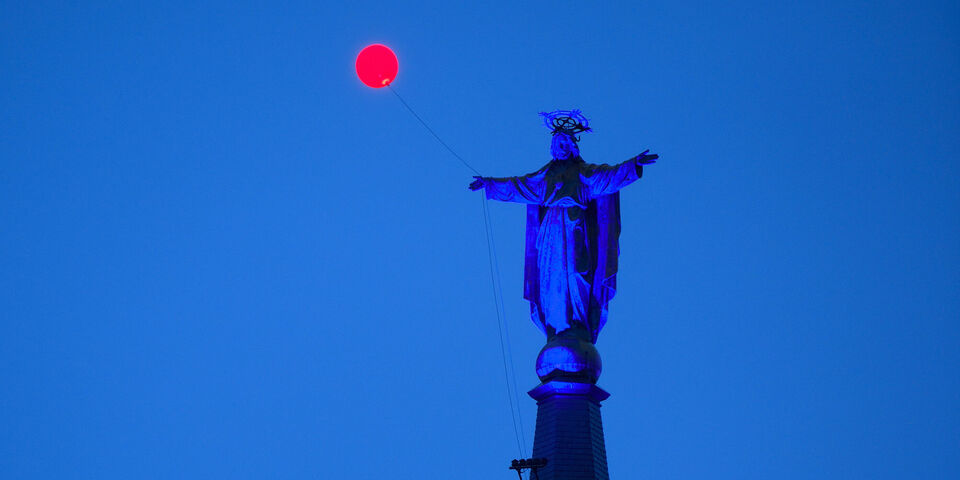Helium from GLOW balloons for TU/e experiments
No Eindhoven resident can have missed them last week, suspended in the air across the city, the large red balloons. At first a mystery, then on Thursday it was plain they were part of the GLOW artwork Connecting the Dots. Now they have been removed and the helium stored at TU/e. Photographer Bart van Overbeeke was there and made the following photo reportage.
Spread across the entire city thousands of red balloons were suspended in honor of GLOW 2020. Sadly, however, many were burst in the storm Monday night a week ago. The idea (as the GLOW organizers envisaged in April) was that the helium gas could be collected from six hundred full balloons. It is estimated that eventually only ten percent of this amount made its way to TU/e.
The thousands of red balloons were strung up by volunteers at the Lichtjesroute ('route of lights') Eindhoven foundation and connected to the mains supply to light up the power LED each contains. The balloon on the statue of Christ on the former Paterskerk was a very tricky one to install. See the main photo.
The full balloons were collected and taken to TU/e by a soldier. The shreds of red remains were collected and the lamps separated from the red latex, a natural material. “That will be recycled elsewhere,” says Herman Leijssen, manager of TU/e's Cryogenic Service. He is the man who ensures the labs are supplied with the gases that are needed and who is now ensuring that the helium used at GLOW is put to good use.
In Cascade the balloons were pumped out. According to Leijssen, on average 120 liters of gaseous helium can be recovered from each balloon. The recycling arrangement is helping to make GLOW more sustainable. “There isn't any real environmental damage and in economic terms some sixty balloons have no great value - if you factor in that four people spent a whole day setting out the balloons. But helium is a rare commodity. Having escaped from a balloon, it will be out of the atmosphere in no time at all.”
Liquid helium is used in certain experiments that require extremely low temperatures. “TU/e acquired the Liquefactor machine (not shown in the photo, ed.) way back in 1989. It enables us to convert helium gas into liquid helium: from 700 liters of gaseous to 1 liter of liquid. Helium is the smallest-but-one molecule that exists,” says Leijssen. “The liquid is used as part of tests carried out at Applied Physics, Electrical Engineering and NanoLab.” With the aid of helium, experiments can be performed at 4.2 Kelvin (-268.8 °C).
With this initiative TU/e has recovered 19,200 liters of helium. Another factoid: guess how many meters of electricity wiring were used in Connecting the Dots? Perhaps as much as six kilometers! “Each of these thousands of balloons was connected to a power cord five or six meters long,” says Leijssen.
In these yellow bags made of very thick PVC, the buffer tanks, the helium gas is stored. As soon as the balloon is almost full, the gas is automatically pumped into 50-litre steel cylinders standing outside Cascade. The empty bag hanging above the cylinders is the reserve. Leijssen is storing the liquid helium in a large tank with a capacity of 2200 liters. This stands indoors at Cascade, next to his office.












Discussion